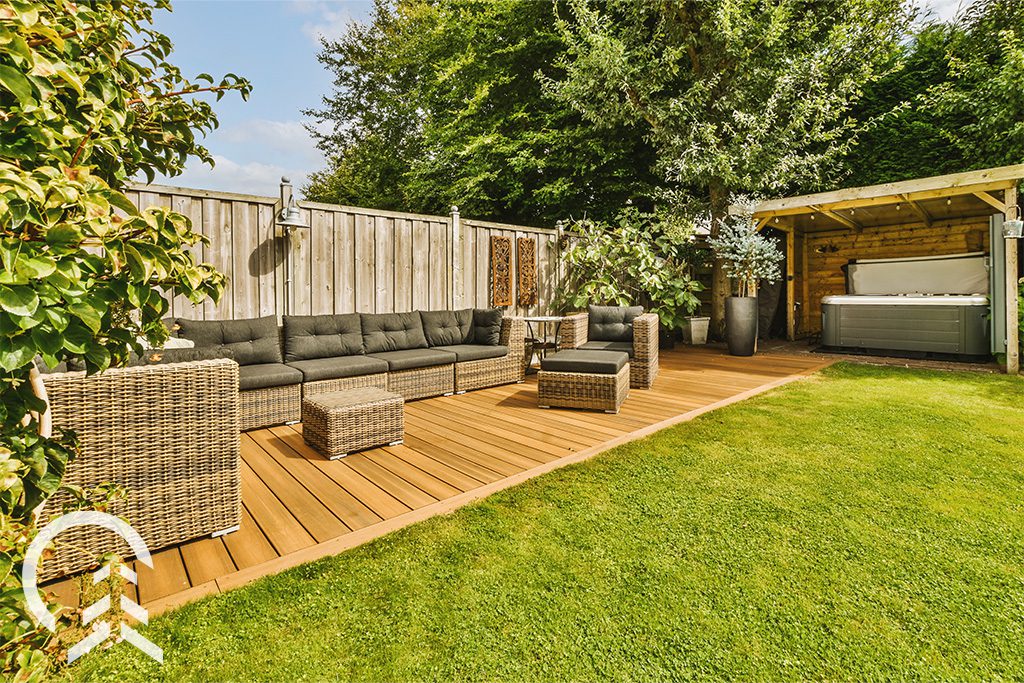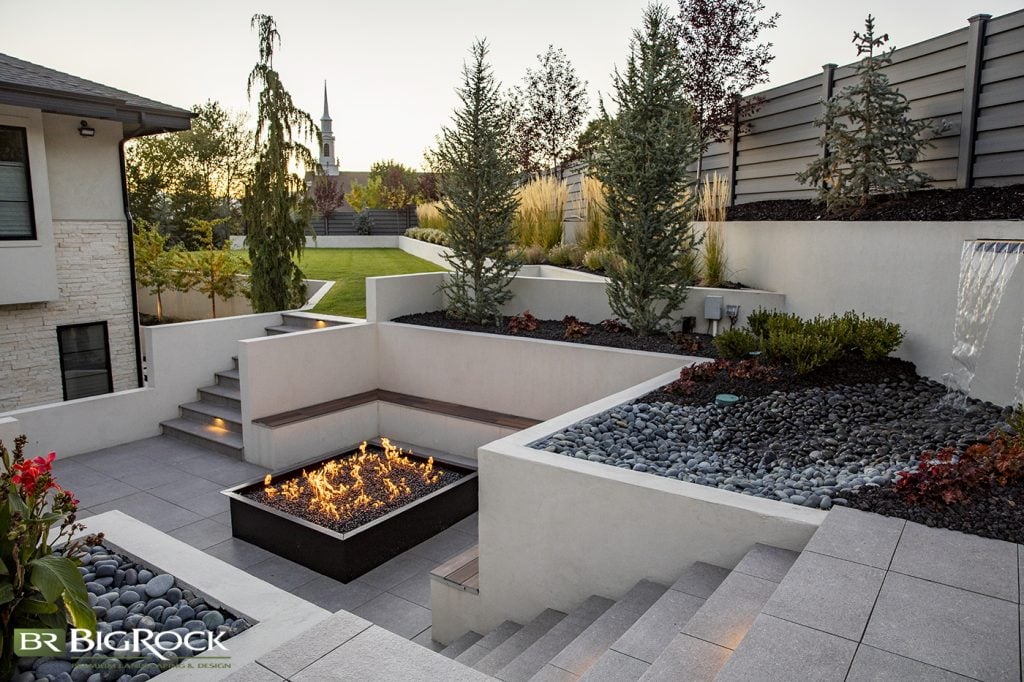Change Your Garden With Cutting-edge Landscape Design Ideas and Strategies
Changing a garden calls for thoughtful consideration of its special attributes. Reliable landscape Design can enhance both capability and aesthetic allure. By checking out different strategies, one can create a room that not just reflects personal design yet likewise sustains neighborhood biodiversity. As the trip unfolds, concerns regarding plant sustainability, format, and choice emerge, prompting a deeper exploration into just how to make these concepts come to life.
Examining Your Outdoor Room: Recognizing Your Garden's Potential
Assessing outdoor area is vital for reliable landscape layout. Recognizing the unique attributes of a yard enables designers to maximize its possibility. Variables such as soil top quality, sunshine direct exposure, and existing structures play a crucial duty in establishing what can be attained. Evaluating the topography helps determine areas for growing, paths, or water features, while keeping in mind drainage patterns assures that plants flourish without waterlogging.
Additionally, acknowledging the garden's microclimates can influence plant option and positioning. Observing how the room is utilized by locals educates useful Design options, such as seating areas or play zones. Furthermore, thinking about the surrounding setting and surrounding landscapes can supply ideas and context for Design decisions. By completely analyzing these aspects, one can create a natural and inviting exterior area that shows the owner's vision while balancing with nature. Ultimately, a thorough analysis lays the foundation for a successful landscape Design project.
Picking the Right Plants: An Overview to Color, Appearance, and Seasonal Interest
When picking plants for a landscape style, comprehending the interaction of color, appearance, and seasonal rate of interest is essential for developing a dynamic and dynamic garden. Shade can stimulate feelings and set the tone for the area; subsequently, choosing an unified combination boosts aesthetic appeal. Warm tones like reds and oranges produce energy, while cooler colors like blues and eco-friendlies provide serenity.
Structure adds deepness and measurement, enabling for a mix of foliage sizes and shapes. Integrating fine-textured plants with bold-leaved selections develops contrast and intrigue.
Seasonal rate of interest is essential for keeping year-round elegance. Picking a range of plants that grow in various seasons guarantees that the garden remains dynamic, shifting from spring's lively flowers to fall's rich foliage. By thoughtfully taking into consideration these aspects, one can curate a landscape that is not only aesthetically pleasing yet additionally varied and interesting throughout the year.

Developing Practical Zones: Creating Spaces for Leisure and Home entertainment
Creating functional zones in a landscape Design boosts the use of exterior spaces, allowing property owners to seamlessly mix relaxation and enjoyment. By thoughtfully splitting areas into unique zones, individuals can provide to numerous tasks, from silent resorts to dynamic celebrations. A properly designed room may include a comfortable reading nook nestled among rich greenery, giving a tranquil getaway (Landscaping Design San Diego). On the other hand, a dynamic outdoor dining location can function as the perfect setup for celebrations with friends and family
Strategically positioned pathways can lead visitors in between these zones, making sure easy navigating. Additionally, incorporating elements like seating locations, fire pits, or water features can boost the total setting and functionality. The combination of different textures and colors in each zone can produce visual interest while preserving a cohesive aesthetic. Inevitably, making practical areas enables property owners to optimize their exterior experience, transforming their yards into functional spaces that fulfill varied way of living requirements.
Incorporating Hardscape Components: Patios, Walkways, and Focal Points
Including hardscape elements into landscape Design enhances functional zones by offering framework and visual appeal. Patios act as essential exterior living areas, allowing property owners to delight in dishes and celebrations in a specified location while enhancing availability. The option of materials, such as natural rock or concrete, can substantially affect the total aesthetic, mixing flawlessly with the surrounding environment.
Pathways help with activity with the yard, directing site visitors while adding deepness and passion. These paths can be crafted from different materials, including gravel, pavers, or block, each adding to the yard's character.
Centerpieces, such as attractive stones, sculptures, or water attributes, draw the eye and produce a sense of purpose within the landscape. Purposefully positioned, these components can transform an average garden right into a fascinating area, inviting exploration and engagement. Through thoughtful combination of hardscape, a landscape comes to be not just practical but likewise visually stunning.
Enhancing Privacy and Safety: Natural Barriers and Frameworks
To boost privacy and safety and security in landscape layout, making use of all-natural obstacles such as dense hedges can effectively secure a residential or commercial property from unwanted sights. Furthermore, mounting personal privacy Landscaper fencings provides a solid framework that adds to a sense of safety and seclusion. Together, these components develop an even more intimate exterior area while hindering potential invasions.
Planting Thick Hedges
While many property owners look for visual allure in their landscapes, planting dense bushes serves a dual function of enhancing personal privacy and security. These all-natural barriers produce a visual guard, successfully blocking the view from spying eyes and discouraging potential intruders. Numerous types, such as boxwood, holly, or privet, can be selected for their development patterns and vegetation thickness, ensuring lavish protection throughout the year. Furthermore, well-maintained bushes can add to a relaxing setting, absorbing sound and giving a habitat for wild animals. The critical positioning of these hedges can specify building boundaries and produce secluded outside rooms, allowing property owners to enjoy their yards with a sense of safety and security. Inevitably, dense bushes are a reliable service for mixing charm with capability.
Installing Privacy Fences
Personal privacy fences serve as one more effective technique for enhancing personal privacy and safety in property landscapes. These frameworks not only define residential or commercial property borders but likewise create a feeling of privacy, shielding home owners from prying eyes. Numerous products, such as timber, plastic, and metal, deal unique looks and levels of resilience, permitting homeowners to select based upon their Design choices and maintenance needs.

Lasting Landscape Design: Eco-Friendly Practices for a Greener Garden
Sustainable landscape design stresses the importance of native plant choice and water preservation methods. By choosing plants that are well-adapted to the neighborhood environment, gardeners can minimize upkeep and resource use. Carrying out reliable watering methods additionally enhances the garden's environmental benefits, advertising a healthier ecological community.
Native Plant Choice
Indigenous plant choice plays a crucial role in sustainable landscaping, promoting biodiversity and lowering the requirement for chemical inputs. By picking plants native to a specific region, gardeners can produce environments that support neighborhood wildlife, such as pollinators, birds, and helpful insects. These plants are adapted to the neighborhood climate and dirt have a peek here problems, calling for less water and upkeep compared to non-native varieties. Additionally, indigenous plants can help regulate erosion and enhance dirt health and wellness, promoting a well balanced ecosystem. Integrating native types right into landscape makes not only boosts the visual appeal of the garden yet also contributes to ecological resilience. Ultimately, indigenous plant choice is an important approach for those seeking to grow a sustainable and vivid yard.
Water Conservation Techniques
Incorporating indigenous plants can substantially improve water preservation efforts in landscaping. These plants are well-adapted to local environments, calling for much less water and maintenance than non-native ranges. Executing drip irrigation systems enables targeted watering, lessening dissipation and overflow. Rain harvesting systems can also be set up, keeping and accumulating rain for garden usage. Mulching helps keep dirt moisture, reducing the frequency of watering. Organizing plants with comparable water needs with each other produces reliable sprinkling zones, further conserving water. Furthermore, utilizing permeable materials for paths permits rain to permeate into the ground, replenishing groundwater products. By using these water conservation methods, garden enthusiasts can produce lasting landscapes that thrive while minimizing ecological impact (Landscape Architect). Such techniques add to a greener yard and a healthier ecological community
Individualizing Your Layout: Adding One-of-a-kind Attributes and Individual Touches
How can one change a yard into an individual shelter? Individualizing a landscape Design includes integrating special features that reflect private tastes and way of livings. One strategy is to include personalized yard art, image source such as sculptures or handmade birdhouses, which can function as prime focus and discussion starters. In enhancement, personalizing plant choices based on personal preferences or seasonal flowers can create a lively and advancing area.
Developing useful locations, such as a comfy reading space or an exterior dining area, can boost usability and convenience. Moreover, including components like a fire pit or a water feature can introduce a welcoming setting.
Color systems, textures, and materials need to align with the house owner's style, whether it be modern, rustic, or eclectic. Inevitably, the objective is to create a room that reverberates with the individual's identification, making the yard not simply a visual pleasure yet a true extension of the home owner's personality.
Often Asked Inquiries
Just how Do I Allocate a Landscape Design Project?
To spending plan for a landscape Design job, one need to assess task scope, research expenses for materials and labor, prioritize functions, and allot an added 10-20% for unexpected expenditures, guaranteeing a reasonable monetary plan.
What Equipment Are Necessary for Home Yard Landscape Design?
Essential devices for home garden landscape design consist of a shovel, rake, yard fork, pruning shears, hoe, wheelbarrow, and trowel. These tools help in dirt prep work, planting, upkeep, and effective transportation of materials throughout the landscaping project.
Exactly How Can I Maintain My Yard After Revamping?
To preserve a redesigned yard, routine watering, mulching, weeding, and pruning are necessary (Landscape Architect). Tracking plant health, readjusting dirt nutrients, and seasonal plant care add to a thriving environment that showcases the yard's new Design effectively
When Is the Ideal Time to Beginning Landscaping?

Can I DIY My Landscape Design or Should I Hire an Expert?
Individuals can absolutely DIY their landscape Design if they have imagination and fundamental skills; nonetheless, employing an expert typically guarantees an extra natural and experienced result, specifically for complex jobs or specific Design goals.
Acknowledging the garden's microclimates can influence plant choice and placement. When choosing plants for a landscape layout, understanding the interaction of shade, structure, and seasonal passion is necessary for creating a dynamic and vibrant garden. Selecting a selection of plants that flower in different periods guarantees that the yard stays vibrant, changing from springtime's lively flowers to autumn's abundant foliage. Incorporating indigenous varieties into landscape designs not just enhances the aesthetic allure of the garden yet likewise contributes to environmental strength. Necessary tools for home yard landscape design include a shovel, rake, yard fork, pruning shears, hoe, trowel, and wheelbarrow.